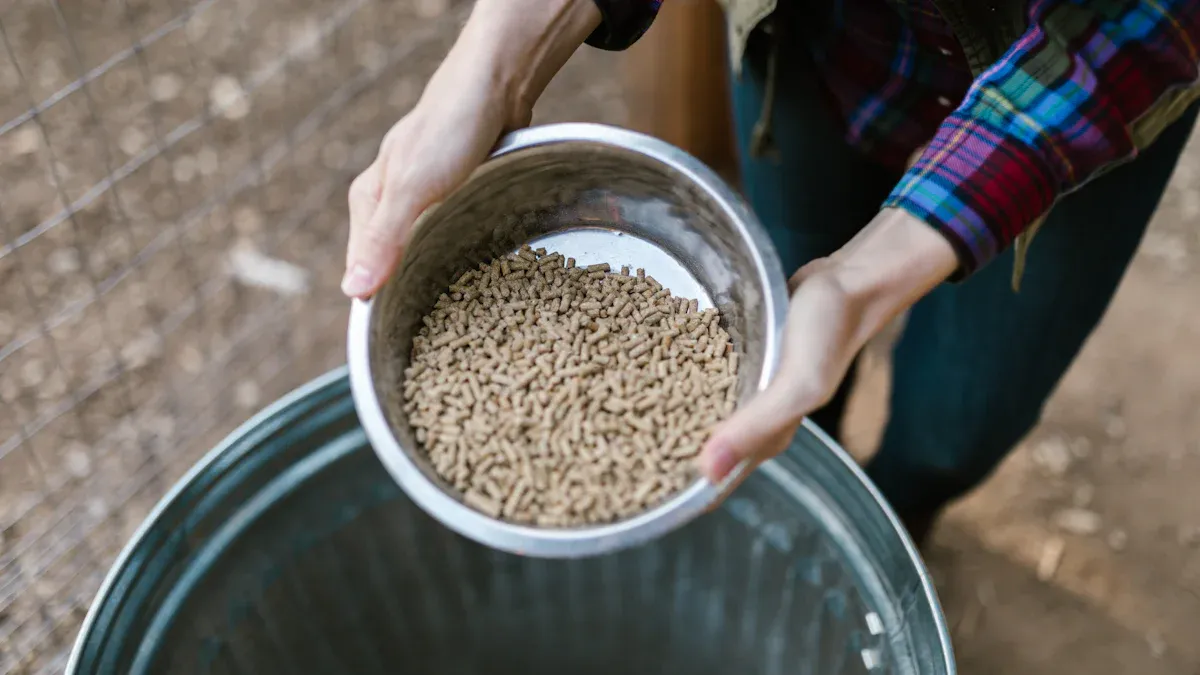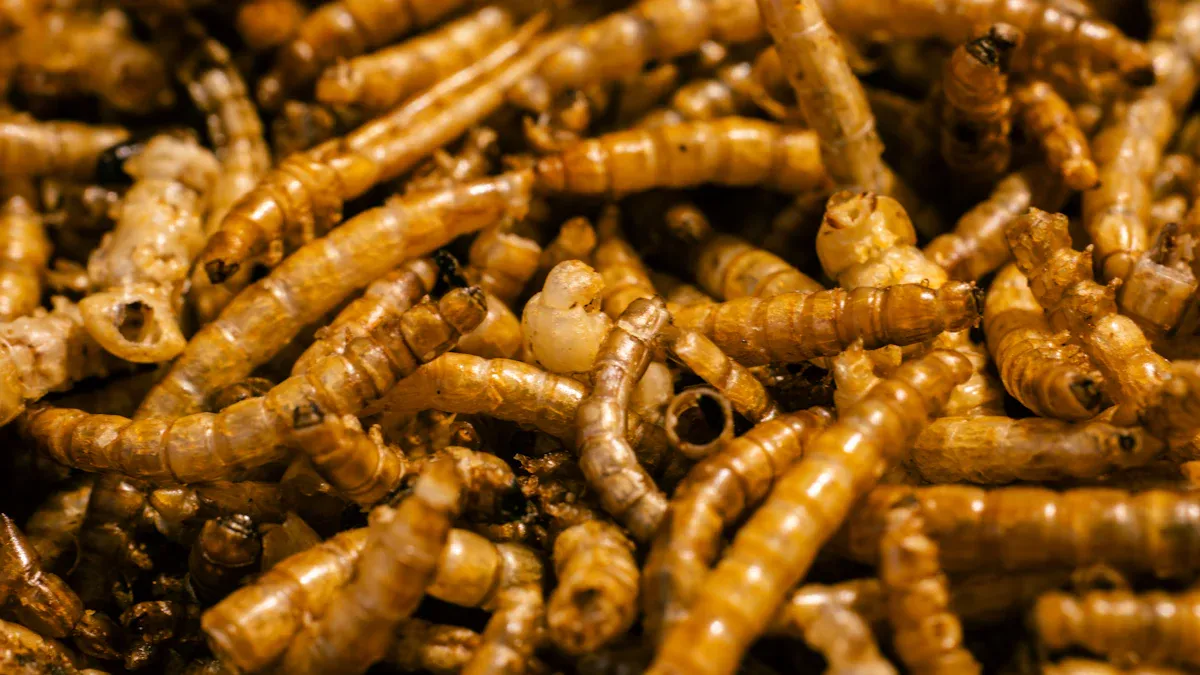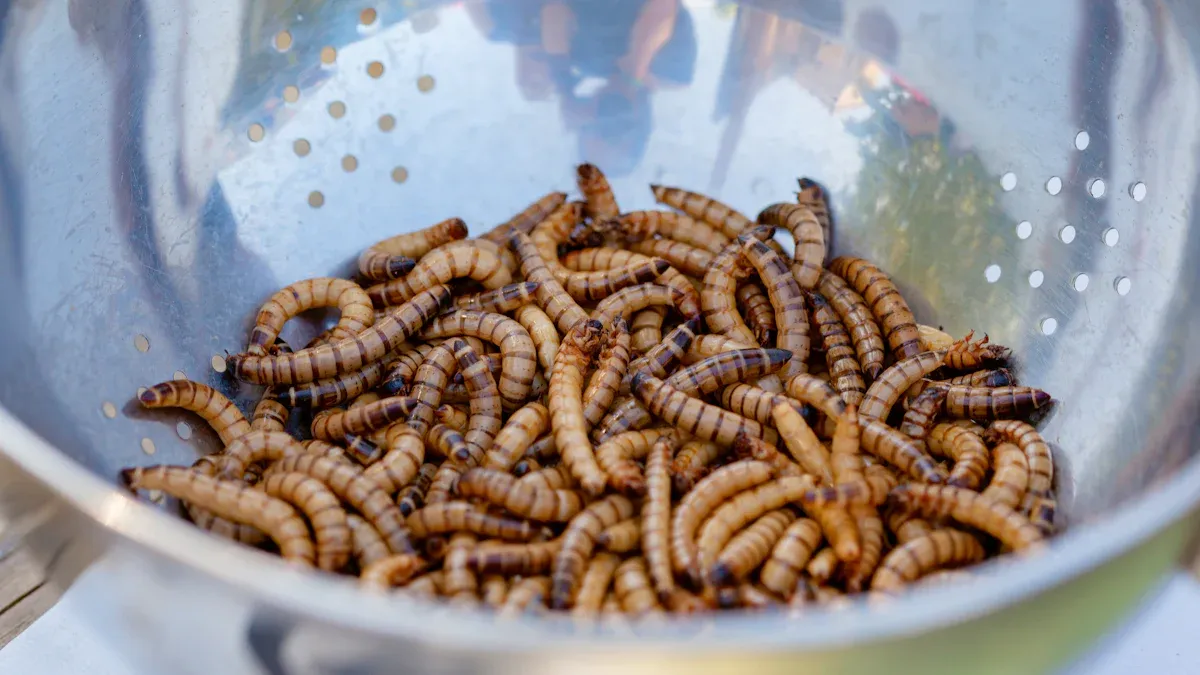
Choosing the right feed for poultry can feel overwhelming. Both mealworms for poultry growth and grains offer valuable nutrients that support healthy flock development. Mealworms, however, stand out for their high protein, fat, and calcium content. They deliver essential nutrients in a balanced proportion, making them a powerhouse option for poultry growth. Grains, on the other hand, are more economical and widely available. Factors like cost, availability, and the flock’s nutritional needs often guide the decision. For instance, farmers with higher education levels tend to explore mealworms for poultry growth, while older farmers may prefer sticking to grains.
Key Takeaways
- Mealworms are full of protein and nutrients for poultry. They help with muscle growth and better egg production.
- Regular feed is cheaper and easy to find. It works well for farmers with many birds.
- Mixing mealworms with regular feed gives better nutrition. This helps birds grow healthy and stay strong.
Mealworms for Poultry Growth

Nutritional Profile of Mealworms
Mealworms pack a powerful punch when it comes to nutrition. They are rich in protein, fats, and essential amino acids, making them an excellent choice for poultry. On a dry matter basis, Austrian mealworms boast a protein content of 53.78%, which is comparable to broiler chicken. In fact, mealworms contain between 13.68 and 22.32 grams of protein per 100 grams of their edible portion. This high protein content supports muscle development and feather growth in poultry. Additionally, mealworms provide essential amino acids like leucine and lysine, which aid in muscle repair and calcium absorption. These nutrients are vital for healthy growth and egg production.
Benefits of Mealworms for Poultry
Feeding mealworms to poultry offers several advantages. Their high protein content enhances growth rates and improves feather quality. Poultry fed with mealworms often produce eggs with better flavor and size. Mealworms also promote gut health by reducing harmful bacteria, which can lead to a healthier flock overall. Moreover, they encourage natural foraging behavior, providing environmental enrichment for the birds. However, it’s important to note that mealworms should not be the sole food source, as they lack certain nutrients like calcium. A balanced diet is key to avoiding potential health issues.
Environmental and Sustainability Advantages
Mealworms are not just good for poultry; they’re great for the planet too. Compared to traditional livestock feed, mealworms require significantly less land, water, and energy to produce. For instance, mealworm farming uses only 10% of the land needed for beef production. They also emit 23% less greenhouse gas, with 1 kg of edible mealworm protein producing just 20.4 kg CO2-equivalent emissions. Additionally, mealworms can be reared on organic waste, reducing the need for conventional feed resources and helping mitigate waste disposal issues. These factors make mealworms a sustainable and eco-friendly option for poultry feed.
Traditional Feed for Poultry Growth
Types of Traditional Feed
Traditional poultry feed comes in various forms, each catering to different needs. Common types include mash, pellets, and crumbles. Mash is a loose, finely ground feed that young chicks can easily consume. Pellets, on the other hand, are compact and reduce waste, making them a popular choice for adult birds. Crumbles fall somewhere in between, offering a texture that’s easy to eat but less messy than mash. Farmers often choose based on the age and specific requirements of their flock.
Nutritional Profile of Traditional Feed
Traditional feed primarily consists of grains like corn, wheat, and soybeans. These ingredients provide a balanced mix of carbohydrates, proteins, and fats. While grains may not match the protein and calcium levels found in mealworms, they offer essential nutrients that support energy and growth. A typical feed might contain around 16-18% protein, which is adequate for most poultry. Vitamins and minerals are often added to ensure a well-rounded diet.
Benefits of Traditional Feed for Poultry
Traditional feed offers several advantages. It’s widely available and cost-effective, making it a practical choice for many farmers. The consistent formulation ensures that poultry receive a steady supply of nutrients. This predictability helps maintain healthy growth and egg production. Additionally, traditional feed is easy to store and handle, reducing the hassle for farmers. While mealworms provide a protein-rich alternative, grains remain a staple due to their affordability and accessibility.
Tip: Mixing different types of feed can optimize nutrition and cater to the specific needs of your flock.
Comparative Analysis: Mealworms vs Traditional Feed

Nutritional Content Comparison
Both mealworms and grains have their benefits and nutritional value in favor of the healthy growth of your flock. However, insect feed is more protein, fat, and calcium-rich when compared to grains. In addition, they provide all essential nutrients at once in a balanced proportion. Mealworms, for instance, contain 46-53% protein, which is crucial for egg-laying birds and feather regrowth during molting. Grains, on the other hand, offer a steady supply of carbohydrates and moderate protein levels (16-18%), making them a reliable energy source.
Cost and Availability
Mealworms are generally more expensive than grains, which makes them less accessible for farmers managing large flocks or working with tight budgets. Grains are widely available and cost-effective, making them a staple for most poultry farmers. However, mealworms can be raised at home or harvested in the wild, which reduces costs and increases availability in regions where traditional feed sources are limited. Their ability to thrive in vertical farming setups also makes them a space-efficient option.
Health Benefits for Poultry
Mealworms offer unique health advantages. They enhance immune function due to chitin, an immunostimulant found in their exoskeletons. Their antimicrobial properties improve gut health, reducing harmful bacteria like salmonella. Additionally, mealworms promote natural foraging behavior, which reduces stress and improves overall well-being. Grains, while less specialized, provide consistent nutrition that supports steady growth and egg production.
Feeding Guidelines and Practicality
Feeding mealworms requires careful planning. They lack calcium and should only supplement a balanced diet. Overfeeding can lead to health issues, so moderation is key. Grains, in contrast, are easier to store, handle, and feed. They form the bulk of most poultry diets without requiring additional preparation. However, mealworms can be stored long-term by drying or freezing, offering flexibility for farmers who choose to incorporate them.
Environmental and Ethical Considerations
Mealworms have a lower environmental impact compared to traditional feed. Producing 1 kg of edible mealworm protein generates only 20.4 kg of CO2 emissions, significantly less than grains. They also require less land and water, making them a sustainable choice. Ethically, mealworms raise fewer concerns than traditional feed, which often involves intensive farming practices. However, the lack of a regulatory framework in some regions may hinder their widespread adoption.
Practical Recommendations
When to Use Mealworms
Mealworms shine during specific periods in a chicken’s life. Their high protein content (46-53%) makes them ideal for egg-laying hens and birds going through molting. Protein supports egg quality and helps chickens regrow feathers, which is crucial for their health. Additionally, the chitin in mealworms’ exoskeletons improves gut health by reducing harmful bacteria. This keeps the digestive system functioning smoothly.
Mealworms also encourage natural foraging behavior, which reduces stress and improves overall well-being. Farmers can use them as a treat or supplement during growth, molting, or laying periods to give their flock a nutritional boost. However, mealworms should never replace a balanced diet. They work best as a complement to traditional feed.
When to Use Traditional Feed
Traditional feed remains the backbone of poultry diets due to its affordability and availability. Grains like corn and soybeans provide a steady supply of energy and moderate protein levels (16-18%). This makes them suitable for everyday feeding. Farmers in regions with abundant maize and soybean production can keep costs low while ensuring their flock gets essential nutrients.
Precision feeding can further optimize results. Providing the right amount of energy and protein ensures healthy growth and consistent egg production. For farmers managing large flocks or working within tight budgets, traditional feed offers a practical and reliable solution.
Combining Mealworms and Traditional Feed
Combining mealworms with traditional feed offers the best of both worlds. Mealworms improve gut health, boost immune function, and enhance nutrient absorption. Their high fat content provides extra energy, especially during colder months. Meanwhile, grains ensure a consistent supply of carbohydrates and essential vitamins.
To maintain balance, mealworms should make up no more than 10% of the total diet. The remaining 90% should consist of traditional grains. This ratio ensures poultry receive all the nutrients they need for optimal growth, egg production, and overall health. By blending these feeds, farmers can create a sustainable and effective diet for their flock.
Both mealworms and grains have their benefits and nutritional value in favor of the healthy growth of your flock. However, insect feed is more protein, fat, and calcium-rich when compared to grains. In addition, they provide all essential nutrients at once in a balanced proportion.
Mealworms for Poultry Growth offer a high-protein, sustainable option, while traditional feed remains cost-effective and widely available. The choice depends on your flock’s needs, budget, and goals. Combining these feeds can create a balanced diet that supports growth, egg production, and overall health. For farmers, this approach ensures both practicality and optimal results.
Tip: Use mealworms as a supplement (up to 10% of the diet) alongside grains for the best outcomes.
FAQ
What makes mealworms better than grains for poultry?
Mealworms contain more protein, fat, and calcium than grains. They also provide essential nutrients in a balanced proportion, supporting faster growth and better egg production.
Can mealworms replace traditional feed entirely?
No, mealworms should only supplement traditional feed. They lack certain nutrients like calcium and carbohydrates, which grains provide. A balanced diet ensures optimal poultry health and growth.
How much mealworm should I feed my poultry?
Mealworms should make up no more than 10% of the total diet. This ratio ensures poultry get the benefits of mealworms while maintaining a balanced nutritional intake.


